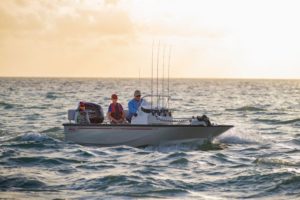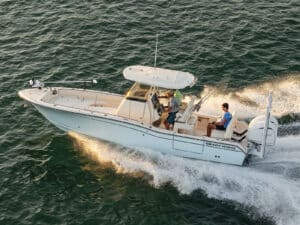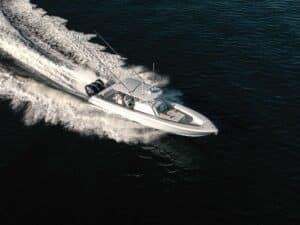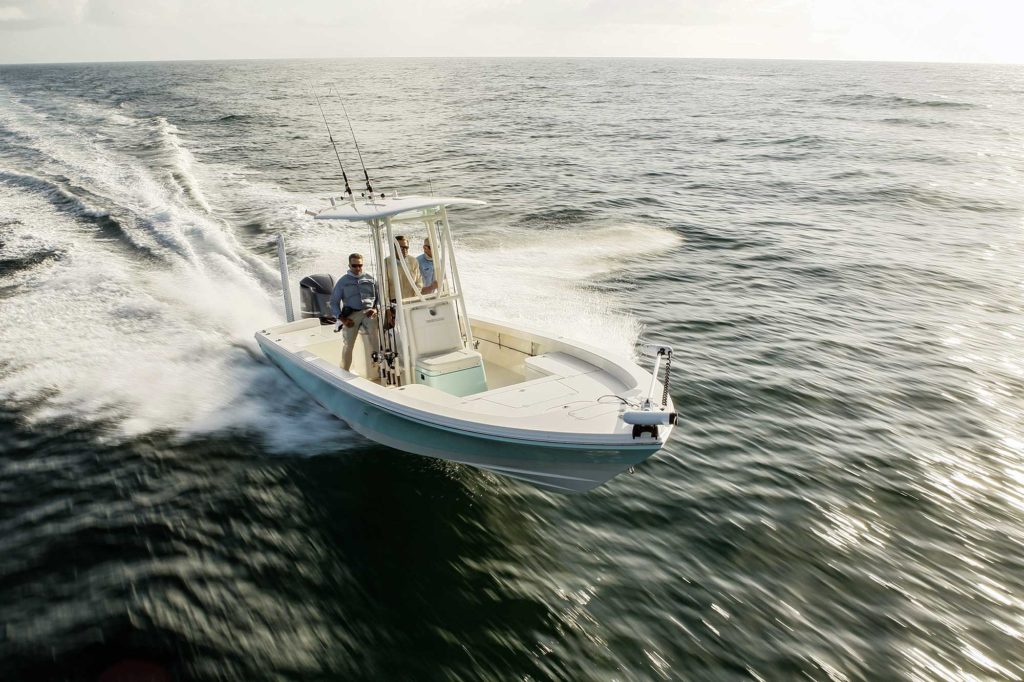
Bay boats have grown wildly popular for saltwater fishing. They are, of course, ideally suited for fishing bays and estuaries. But many anglers also expand the use of these models to target bluewater gamefish such as mahi, sailfish and tuna, as well as cobia, grouper and snapper on coastal wrecks. This trend has not gone unnoticed by the companies that build bay boats, which have responded over the past few years by creating hybrid models such as the Barker 26 Open, Jupiter 25 Bay, Pathfinder 2500 Hybrid and Yellowfin 26 Hybrid that seem equally at home whether fishing bay waters or blue water.
The main difference lies in the deck layout. Hybrid decks often minimize the elevated fore and aft casting platforms on traditional bay boats, substituting deeper decks for greater security when fishing in rough conditions.
To achieve this, the Pathfinder 2500 Hybrid, for example, carries a deep deck nearly all the way aft, with only an abbreviated stern platform, but also retains a full bow platform. Models such as the Barker 26 Open and Jupiter 25 Bay dispense with elevated platforms all together.
Whether you choose to head offshore in a traditional bay boat or a hybrid version, you’ll find that certain optional equipment and other features can help you maximize the effectiveness of these boats when fishing outside the bays.
Ride On
If you’ve never ventured outside the jetty aboard a bay boat, you might be surprised by how smooth the hulls can run in ocean waves. While these craft possess a shallow deadrise at the transom (to minimize draft for fishing shallow water) compared with offshore hulls, many bay boats also feature a progressive V-hull running surface that offers a sharp entry.
The key to a smooth ride is keeping the forward V knifing the water, says Charlie Johnson, marketing director for Maverick Boat Group, which builds Pathfinder bay boats. “Bay boats with stepped-hull designs, including the Pathfinder 2500 Hybrid and 2600 HPS, do this naturally by creating a flatter running attitude that keeps the bow down,” Johnson points out.
You can create the same effect with a bay boat with a conventional V-hull by deploying the trim tabs downward to create a flatter ride that keeps the forward V cutting through the waves, he adds.
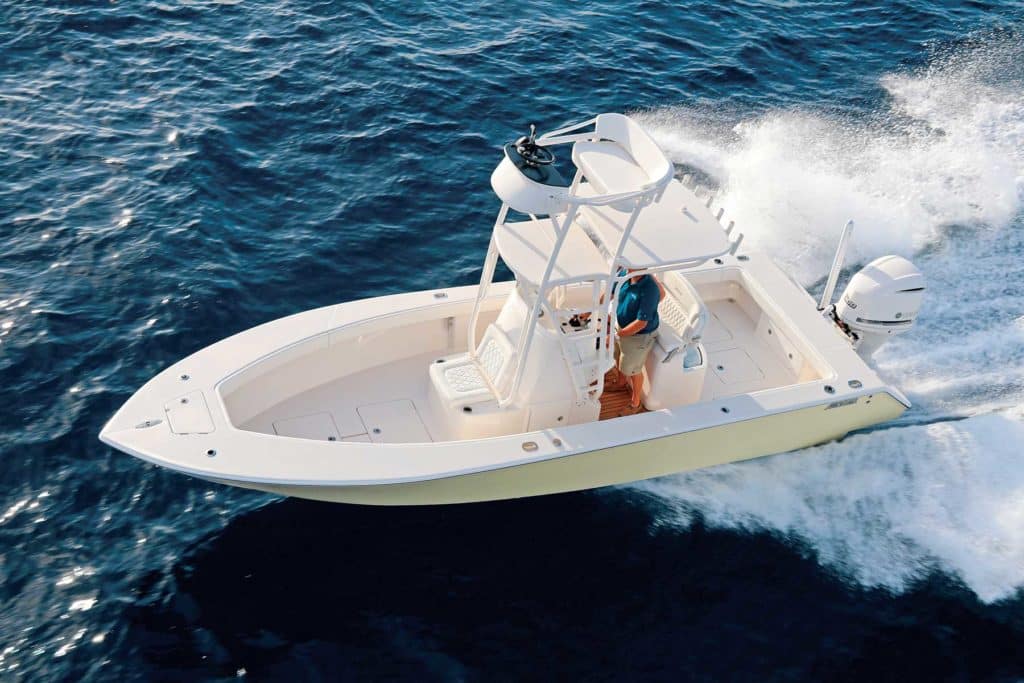
Going Aloft
Towers with second helm stations offer big advantages when offshore fishing. The extra elevation lets you better spot birds, breaking fish, weed lines and other fish-holding flotsam from a distance.
“I love to use the tower [on the Barker 26 Open] for trolling weed lines,” says Kevin Barker, president of Barker Boatworks. “It’s easier to follow a weed line and avoid fouled lures, and I can see a school of fish at a much greater distance than I can from the deck.”
It’s also easier to monitor the trolling spread or slow-trolled live baits from aloft, and you can often peer down from above to see schools of bait or a squadron of mahi in the clear water under the boat, Barker says.
Many bay-boat towers utilize the top of the center console as the footpad for the occupant, although the tower on the Jupiter 25 Bay has a foot stand that sits above the windshield. Some towers also come with benches so you don’t have to stand all of the time. The elevated helm station often includes a networked multifunction display (MFD), so you can call up the chart plotter, sonar and other electronic functions from the tower.
Towers aside, a hardtop is a great option for bay boats that might see bluewater action. It offers an ideal place to mount outriggers for trolling, and also provides a means of adding antennas and radar scanners.
Powerful Electronics
Having a powerful chirp fish finder on a bay boat can make a difference when fishing a wreck or looking for schools of bait in deeper water. For anglers planning to venture offshore, Barker usually rigs a 26 Open or 26 Calibogue Bay with a 16-inch MFD at the helm. A 1 kW flush-mount, tilted-element chirp transducer, such as an Airmar B175HW, is often mated to the fish finder.
“This lets the angler read wrecks and bait in deep water,” he says. The big display allows for a split-screen view of the fish finder, chart plotter and networked systems such as the engine instruments.
Some customers also opt for radar, which can prove helpful when heading out before daylight or safely guide them home if fog rolls in while fishing offshore. The bird mode on some radar systems can also help lead anglers to spots where seabirds have found bait and feeding fish.
Marine radar can help boating anglers detect and monitor storm cells at a distance while offshore. Early detection of an approaching weather system can spell the difference between outrunning the storm or being caught by a dangerous squall.
More Stowage
Generally speaking, offshore fishing is more tackle and equipment intensive, and the gear tends to be larger than that for inshore fishing, Johnson points out. “For instance, offshore anglers carry a gaff, while inshore anglers rarely do,” he says. “Offshore rods and reels are often bigger, and you usually carry more tackle in anticipation of a variety of opportunities, like seeing a school of dolphin (mahi) while you’re wreck-fishing.”
That means having extra stowage on your bay boat. Undergunwale racks for gaffs and extra rod holders across the back of the hardtop and on the leaning post are all helpful on bluewater trips. Also, you’ll want compartments and lockers to accommodate a plethora of offshore lures, terminal tackle, leader material, rigging tools and other items.
In addition, if you plan to anchor on a wreck to fish, make sure you have enough rode to set up properly. A minimum is 3-to-1 scope, but more scope is better, especially when conditions turn rough or a strong current is running.
Many offshore trips result in tasty grouper, mahi, snapper and tuna to take home for dinner, as opposed to many inshore trips that largely involve catch-and-release fishing. So make sure your bay boat has plenty of insulated capacity in the fish lockers for ice and fish. If you’re ordering a new bay boat and you plan to fish offshore, opt for a macerator or diaphragm pump system to evacuate blood and gruel from the fish lockers.
Read Next: 7 Hybrid Bay Boats that Fish Inshore Bays and Blue Water
Livewell Capacity
Having plenty of live bait can lead to success in both inshore and offshore fishing, but many bluewater anglers carry more than one species of bait on board, such as pilchards and goggle-eyes.
This requires two or more livewells so you can separate the baits and prevent the bigger, livelier species from beating up the smaller, more delicate bait. Most bay boats come with a standard livewell in the aft deck, but you can usually order an optional additional well, such as in the leaning post, to satisfy the need for bait separation.
Finally, don’t skimp on power for your bay boat. You might not always use all of the oomph, but it’s good to have power in reserve when you need to respond to climb offshore waves or stay head of a roller as you’re returning through the inlet.

